Overview
In the beginning, the Universe was a void without form or handled ascenders. Then came the Jumar. Cavers who could not afford $15 made the Roloff, but this was a small-scale operation, with only about 120 pairs made. Petzl developed their old-school ascender, now called the Ascension, in 1974, but it did not appear on this side of the pond until about 1979.
In October 1976, Off Belay magazine reviewed “a new ascender which shows a great deal of promise.” This was the Clog expedition. They noted, “The hand opening is large enough to accept an expedition mitt and is fitted with an insulating molded plastic hand grip, features making it attractive for winter and high-altitude use.” My climber friends shared this view, and took it on their ill-fated expedition to Nanga Parbat.
Off Belay (the review’s author was not named) also stated, “There seems to be one inconsistency in either design or production. Some ascenders have a lower carabiner hole while others do not. The carabiner hole is an important feature, especially when the rope runs diagonally…. However, it is easy to add a biner hole with a ½-inch drill.”
So why no hole? Safety. Climbers kept clipping carabiners into the carabiner hole. Sometimes these carabiners rotated, jammed, and broke. Clog responded by removing the hole, hoping to eliminate human stupidity and curtail natural selection, with little success. Few if any other manufacturers followed suit, and we see carabiner holes at the base off many ascenders.
Are these holes unsafe? Given that any rope work has some risk that can be avoided by abstention, one has to say “yes” by definition, but I think this is extreme. I don't mind having “carabiner” holes in my ascenders, since I know the risk; besides, usually (but not always) there are better options than clipping carabiners to ascenders.
I bought my first Clog expedition ascenders in 1978. I found them to be too large, and being rather cumbersome compared to the superb ergonomics of the gray Jumars. These Clogs did not have the hole. Two years later, I was able to buy a new-old-stock older version from an obscure shop in Idaho. That pair had the hole, but instead of the plastic grips, it had softer “rubber” grips glued in place. Since those golden days, I've acquired a number of variations.
Most of the later changes were minor, little things like changing the rivets or changing the safety’s shape or material. The latest version added a cam stop, a rather pointless addition that serves no useful purpose beyond increasing the pull-through force in strength tests. If you weigh enough for that to matter, you’ve got another problem.
There is at least one older version that I do not have and it is high on my “WANTED” list. This version has transverse “Z”-shaped ridges across the cam teeth, much like the early Petzl and Jumar teeth.
Here is a quick summary of the versions in my collection:
- No anodizing, glued rubber hand grips, no Clog logo stamped on shell.
(#2159R)
- Clog logo stamped on shell.
(#24, 1910L, 2158)
- Blue anodized shell, plastic hand grip, eliminated the carabiner hole.
(#2156L)
- Eliminated the Clog logo stamped on shell.
(#2157)
- Blue anodizing, later changed to black. New cam safety mounted on round-head rivet (vs. roll pin on earlier models).
(#25)
- New forged cam safety with nubbin on each side.
(#3458, 3561)
- Orange anodized safety with nubbin on front side only, various stamped markings.
(#1505R, 1567)
- Non-anodized safety.
(#1505L, 3562, 3568)
- Countersunk rivet cam axle (vs. semi-tubular rivet on earlier versions). Some anodized black, some purple.
(#171L, 1555, 2007)
- Plastic safety
(#218, 2166R)
- Pin cam stop
(#26, 172L, 2167R)
|
 |
I have seen photos of two earlier Clog handled ascenders with frames
like my Version A and cams like those on my handleless
Clog ascenders Versions A through E. I would like to get a pair
of each for my collection. If you have ones that you can part with, please
email me. |
|
[ Top
| Version B
| Version C
| Version D
| Version E
| Version F
| Version G
| Version H
| Version I
| Version J
| Version K
| Return to H.E.C. Ascenders
]
Version A
(#2159)
Technical Details
I acquired this ascender in 2017 as part of Bob Thrun’s collection.
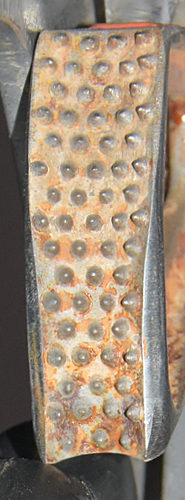 Version A is 195 mm. tall, 109 mm. wide, 25 mm. thick, and weighs 238 g.
Version A is 195 mm. tall, 109 mm. wide, 25 mm. thick, and weighs 238 g.
The ascender shell is a roughly "D" shaped piece
of unfinished 4.2 mm. thick aluminum bent to form a rope
groove on one side and to hold the cam pivot and safety on the
other. The handle opening is fairly large, and a molded rubber
hand grip is glued to the shell. A 15.3 mm. hole at the base
of the shell serves as a rope attachment point. A second 15.3 mm.
hole provides a means to attach non-load-bearing slings to the
shell above the cam. The rope channel is 15 mm. wide.
The cam is a skeletonized steel casting with a (4.5)^4(4.3)^4
conical tooth count. The teeth are well made compared to those
of some other toothed ascenders. The cam radius increases from 43 to 57 mm. over an angle of 41°, giving a 22° cam angle. The inner cam face radius reduces
from top to bottom to accommodate various sized ropes. The cam
and cam spring are mounted on a solid 7 mm. steel pin. The
pin is expanded at both ends to keep it in place. The cam safety
is a crudely machined aluminum lever mounted on a 3 mm. roll
pin in the same shell channel as the cam. A second spring serves
as a safety spring. Normally this spring holds the safety where
it blocks the cam from opening. When the end of the safety lever
is depressed, the opposite end pivots upwards so that the cam
is no longer obstructed.
There are no markings on the shell of this ascender. "CLOG" is cast on top of the cam.
The only significant difference between Version A and Version B is that Version A does not have "CLOG WALES" inside an ellipse stamped on the shell.
[ Top
| Version A
| Version C
| Version D
| Version E
| Version F
| Version G
| Version H
| Version I
| Version J
| Version K
| Return to H.E.C. Ascenders
]
Version B
(#24, 1910, 2158)
Technical Details
I acquired this pair from Mountaineering Outfitters in Driggs Idaho in August 1980, but
the ascender is at least five years older than that,
since Version E was available in 1976. I acquired another left-handed ascender in 2017 as part of Bob Thrun’s collection.
Version B is 195 mm. tall, 109 mm. wide, 25 mm. thick, and weighs 237 g.
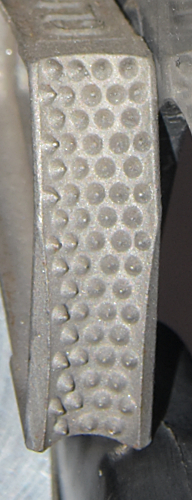 The ascender shell is a roughly "D" shaped piece
of unfinished 4.2 mm. thick aluminum bent to form a rope
groove on one side and to hold the cam pivot and safety on the
other. The handle opening is fairly large, and a molded rubber
hand grip is glued to the shell. A 15.3 mm. hole at the base
of the shell serves as a rope attachment point. A second 15.3 mm.
hole provides a means to attach non-load-bearing slings to the
shell above the cam. The rope channel is 15 mm. wide.
The ascender shell is a roughly "D" shaped piece
of unfinished 4.2 mm. thick aluminum bent to form a rope
groove on one side and to hold the cam pivot and safety on the
other. The handle opening is fairly large, and a molded rubber
hand grip is glued to the shell. A 15.3 mm. hole at the base
of the shell serves as a rope attachment point. A second 15.3 mm.
hole provides a means to attach non-load-bearing slings to the
shell above the cam. The rope channel is 15 mm. wide.
The cam is a skeletonized steel casting with a (4.5)^4(4.3)^4
conical tooth count. The teeth are well made compared to those
of some other toothed ascenders. The cam radius increases from 43 to 57 mm. over an angle of 41°, giving a 22° cam angle. The inner cam face radius reduces
from top to bottom to accommodate various sized ropes. The cam
and cam spring are mounted on a solid 7 mm. steel pin. The
pin is expanded at both ends to keep it in place. The cam safety
is a crudely machined aluminum lever mounted on a 3 mm. roll
pin in the same shell channel as the cam. A second spring serves
as a safety spring. Normally this spring holds the safety where
it blocks the cam from opening. When the end of the safety lever
is depressed, the opposite end pivots upwards so that the cam
is no longer obstructed.
The words "CLOG WALES" inside an ellipse are stamped on the inner shell
surface, and "CLOG" is cast on top of the cam.
This ascender combines a very well made cam with a poorly executed
shell and safety. The cam is identical to the cam on the handleless
Clog Versions E, F & G. There are no sharp edges
on the ascender in either the rope channel or the sling attachment
holes, but the cam pin does have a sharp lip. I don't like the
way the cam pin is expanded, I would prefer to see round head
rivets used here.
Clog ascenders are quite large. This makes them popular among
snow and ice climbers, who must wear heavy mittens while climbing
fixed ropes. Of course, the large size is a disadvantage for caving.
The ascender is easily opened with one hand, but only the wrong
hand. It is very difficult to open the right-hand ascender with
one’s right hand without going through some severe contortions.
The ascender can be removed from the rope by simply depressing
the safety with one’s thumb and lifting up on the handle. It is
much more difficult to put the ascender on the rope with one hand,
particularly the proper hand. Normally it becomes a two-handed
operation.
The rubber hand grip is very comfortable, but is excessively
heavy. The hand grip provides some insulation in winter conditions,
but there is a rib of the aluminum shell exposed next to one’s
palm so the protection is not complete. In many climbing systems
(e.g., the lower ascender in the Mitchell System) ascenders are
pulled up the rope from above. Clog ascenders are not as easy
to grasp from above as some others (such as the Jumar).
The ascender is attached to the harness by a carabiner through
the bottom attachment hole. Clog eliminated carabiner attachment
holes from later expedition ascenders because of two cases of
carabiner failure (see D. Moorhouse, Clog Climbing
Gear, Off Belay #30, Dec. 76, pp. 54-55). These
were caused by sideways gate loading on carabiners lodged incorrectly
in the attachment hole. This could happen also occur with Petzl’s, S.R.T.’s,
handled C.M.I.’s, etc. I caution against
using carabiners for attaching slings to ascenders.
Clog ascenders also have a disadvantage shared by all handled
ascenders using a sheet metal shell. When crossing a sharp lip,
it is very easy to carelessly place the ascender so that the cam
grips the rope just above the lip, while the base of the handle
sticks out over the pit lip. When weight is transferred to the
ascender sling, the shell tends to bend 90°. This effectively
destroys the ascender. Milled or cast frame ascenders, such as
the C.M.I., Jumar,
and S.R.T. are more likely to survive
this mistake.
[ Top
| Version A
| Version B
| Version D
| Version E
| Version F
| Version G
| Version H
| Version I
| Version J
| Version K
| Return to H.E.C. Ascenders
]
Version C
(#2156)
Technical Details
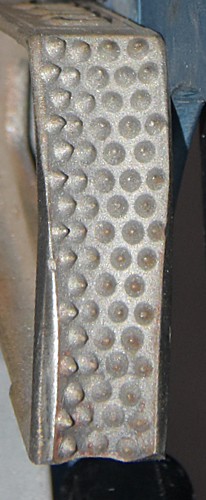 I acquired this ascender in 2017 as part of Bob Thrun’s collection.
I acquired this ascender in 2017 as part of Bob Thrun’s collection.
Version C is 195 mm. tall, 111 mm. wide, 24 mm. thick, and weighs 222 g.
The ascender is very similar to Version B, so only the
differences will be noted. The hand grip is plastic molded onto the shell. A small extension
on the base of the plastic hand grip protects the inside bottom
of the handle opening so that slings can be tied directly through
the handle. The lower attachment hole was eliminated
due to the safety concerns mentioned above. The shell is blue
anodized.
The words "CLOG WALES" inside an ellipse are stamped on the inner shell
surface."CLOG-WALES" is molded into both sides of
the plastic hand grip. "CLOG" is cast on top of the cam.
All of these changes are improvements, except one. Clog eliminated carabiner attachment
holes because of two cases of
carabiner failure (see D. Moorhouse, Clog Climbing
Gear, Off Belay #30, Dec. 76, pp. 54-55). These
were caused by sideways gate loading on carabiners lodged incorrectly
in the attachment hole, but
without the hole there is no easy way to prevent ascender rotation
on horizontal or sloping ropes. The resulting design is something of a nuisance,
since slings must now be tied through the handle. Unfortunately,
the slings pull towards the outside of the ascender, i.e., away
from the rope and towards the hand. This causes the ascender to
pivot slightly when loaded, leading to lost efficiency
The hand
grip is less comfortable than the rubber one of Version B,
but is superior in terms of weight and durability. It also completely
surrounds the aluminum shell, providing better cold weather protection.
I still wish the cam pivot had
been changed, since I really don't trust that style rivet.
[ Top
| Version A
| Version B
| Version C
| Version E
| Version F
| Version G
| Version H
| Version I
| Version J
| Version K
| Return to H.E.C. Ascenders
]
Version D
(#2157)
Technical Details
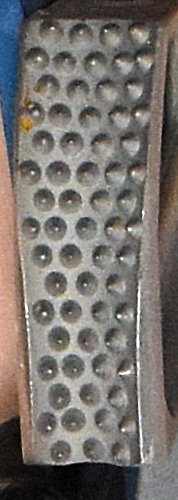 I acquired a left- and two right-handed Version D ascenders in 2017 as part of Bob Thrun’s collection.
I acquired a left- and two right-handed Version D ascenders in 2017 as part of Bob Thrun’s collection.
This version is 195 mm. tall, 110 mm. wide, 24 mm. thick, and weighs 234 g. The rope channel is 15 mm. wide. The cam axle is centered 53 mm. from the inside of the rope channel. The cam radius increases from 43 to 57 mm. over an angle of 41°, giving a 22° cam angle. The tooth pattern is (4.5)^4(4.3)^4.
The ascender is very similar to Version C, the only difference being that the "CLOG WALES" inside an ellipse is no longer stamped inside the frame.
"CLOG-WALES" is molded into both sides of
the plastic hand grip. "CLOG" is cast on top of the cam.
When I acquired Bob’s collection, one of the right-hand Version D ascenders was paired with the Version C ascender, indicating that he acquired them during the transition.
[ Top
| Version A
| Version B
| Version C
| Version D
| Version F
| Version G
| Version H
| Version I
| Version J
| Version K
| Return to H.E.C. Ascenders
]
Version E
(#25, 2157)
Technical Details
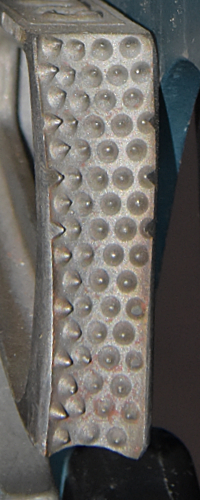 I acquired this pair of ascenders from Avalanche in Pittsburgh,
Pa. in April 1978. At the time it was the current production
model. I acquired two more pair in 2017 as part of Bob Thrun’s collection.
I acquired this pair of ascenders from Avalanche in Pittsburgh,
Pa. in April 1978. At the time it was the current production
model. I acquired two more pair in 2017 as part of Bob Thrun’s collection.
Version E is 195 mm. tall, 107 mm. wide, 25 mm. thick, and weighs 230 g. The rope channel is 14 mm. wide. The cam radius increases from 43 to 57 mm. over an angle of 41°, giving a 22° cam angle. The tooth pattern is (4.5)^4(4.3)^4.
The ascender is very similar to Version C. The aluminum cam safety is more elegantly
shaped, and is mounted with a steel round head rivet.
It functions in the same manner as the safety for Version C.
"CLOG-WALES" is molded into both sides of
the plastic hand grip, and "CLOG" is cast on top of the cam. The shell markings present on Version C were eliminated.
The new cam safety looks much better, but the improvement is mainly cosmetic.
[ Top
| Version A
| Version B
| Version C
| Version D
| Version E
| Version G
| Version H
| Version I
| Version J
| Version K
| Return to H.E.C. Ascenders
]
Version F
(#3458, 3561)
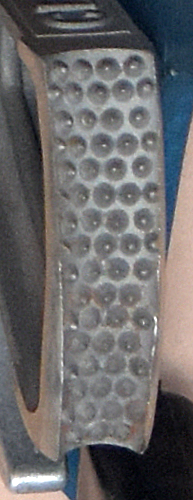 Technical Details
Technical Details
I acquired a pair of Clog Expedition, Version F ascenders from On Rope 1 in 2021. I obtained a second left-handed ascender from Don Koller in 2022.
Version F is 195 mm. tall, 107 mm. wide, 28 mm. thick, and weighs 236 g. The rope channel is 14 mm. wide. The cam axle is centered 53 mm. from the inside of the rope channel. The cam radius increases from 43 to 57 mm. over an angle of 41°, giving a 22° cam angle. The tooth pattern is (4.5)^4(4.3)^4.
Version F differs from Version E by having a different shape to the cam safety. The new safety is an aluminum forging. The safety on earlier versions has flat sides, while the safety on Version F has a raised nubbin on each side on the end near the cam.
"CLOG-WALES" is molded into both sides of
the plastic hand grip, and "CLOG" is cast on top of the cam. There are no shell markings.
The new cam safety looks better, but the improvement is mainly cosmetic.
The nubbins could limit the safety’s lateral motion, helping to center it in the cam channel, but I find mine stay centered without rubbing.
The black anodizing on the right-hand ascender appears to be harder than the blue on the left, but not enough harder for me to categorize this as a different version. The black anodizing on later versions in my collection appears to be soft anodizing as well. I do not see a particular advantage to hard-anodizing stamped-frame ascenders, since the anodizing will wear off inside the shell in either case, especially if one climbs on muddy rope.
[ Top
| Version A
| Version B
| Version C
| Version D
| Version E
| Version F
| Version H
| Version I
| Version J
| Version K
| Return to H.E.C. Ascenders
]
Version G
(#1505R, 1567)
Technical Details
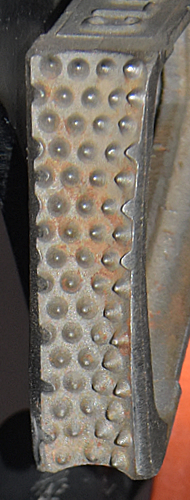 I acquired a right-handed Clog Expedition, Version G ascender from Richard Biggs in 2009, and a pair from Mike Ford in 2012.
I acquired a right-handed Clog Expedition, Version G ascender from Richard Biggs in 2009, and a pair from Mike Ford in 2012.
Version G is 196 mm. tall, 105 mm. wide, 28 mm. thick, and weighs 243 g. The rope channel is 16 mm. wide. The cam radius increases from 43 to 57 mm. over an angle of 41°, giving a 22° cam angle. The tooth pattern is (4.5)^4(4.3)^4. The cam pivot is a semi-tubular rivet.
Version G differs from Version F by having a different shape to the cam safety. The Version G safeties have raised nubbins on only one side, toward the front of the ascender, and so the left and right ascender safeties are mirror images of each other. This raised nubbin can push against the outer lip of the cam channel, centering the safety in the channel (the safety spring limits motion in the other direction). The Version G safety is also anodized.
"CLOG-WALES" is molded into both sides of
the plastic hand grips, and "CLOG" is cast on top of the cam. The first right-handed ascender frame is stamped "T1185." The second is stamped with three illegible digits ("552"??) and "784C." The left-handed ascender is stamped "SECOND" in two places, "4 84," and "TES ED" [sic].
The date stamp indicates that these were made in 1984 and 1985.
The left-handed ascender is interesting because it was a factory second with cosmetic blemishes. Since I acquired this one used, I cannot tell what the original blemish was. Mike wrote, "These are date stamped 1984 and are cosmetic seconds due to what was considered poor black spray paint job but I think they are A1."
[ Top
| Version A
| Version B
| Version C
| Version D
| Version E
| Version F
| Version G
| Version I
| Version J
| Version K
| Return to H.E.C. Ascenders
]
Version H
(#1505L, 3562,3568)
Technical Details
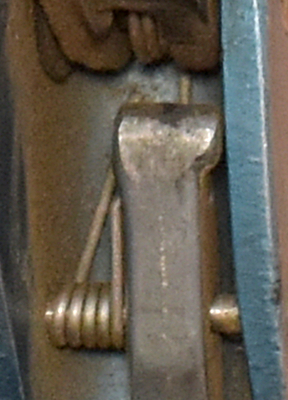
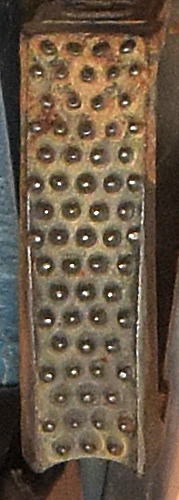 I acquired a black left-handed Clog Expedition, Version H ascender from Richard Biggs in 2009, a blue right-handed one from Don Koller in 2022, and a red left-handed one from Rob Byrom, also in 2022.
I acquired a black left-handed Clog Expedition, Version H ascender from Richard Biggs in 2009, a blue right-handed one from Don Koller in 2022, and a red left-handed one from Rob Byrom, also in 2022.
Version H is 196 mm. tall, 105 mm. wide, 28 mm. thick, and weighs 243 g. The rope channel is 16 mm. wide. The cam radius increases from 43 to 57 mm. over an angle of 41°, giving a 22° cam angle. The tooth pattern is (4.5)^4(4.3)^4. The cam pivot is a semi-tubular rivet.
The safety is the same shape as the Version G safety, but is not anodized.
"CLOG-WALES" is molded into both sides of
the plastic hand grips, and "CLOG" is cast on top of the cam. The left-hand ascender frame is stamped "T586."
The date stamp indicates that the left-hand ascender was made in 1986. The right-handed one does not have a date stamp. The blue frame on the right-handed ascender indicates that it is older than the black-framed left-handed ascender.
[ Top
| Version A
| Version B
| Version C
| Version D
| Version E
| Version F
| Version G
| Version H
| Version J
| Version K
| Return to H.E.C. Ascenders
]
Version I
(#171, 1555)
Technical Details
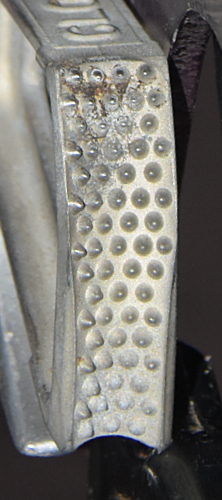 I acquired a left Clog Expedition, Version H ascender from Terry Wilkins in 2004, a complete pair from from Lawrence Rowles in 2011, and another pair from Steve Swanchak in 2015.
I acquired a left Clog Expedition, Version H ascender from Terry Wilkins in 2004, a complete pair from from Lawrence Rowles in 2011, and another pair from Steve Swanchak in 2015.
Version I is 195 mm. tall, 105 mm. wide, 28 mm. thick, and weighs 237 g. The rope channel is 16 mm. wide. The cam radius increases from 43 to 58 mm. over an angle of 41°, giving a 23° cam angle. The tooth pattern is (4.5)^4(4.3)^4.
"CLOG-WALES" is molded into both sides of
the plastic hand grips, and "CLOG" is cast on top of the cam. Each frame is stamped with the letter "C."
Version I differs from Version H by having a countersunk rivet rather than a semi-tubular rivet for the cam axle. Neither cam safety is anodized. The Version I pair that I acquired from Lawrence Rowles is anodized purple, the others are black.
[ Top
| Version A
| Version B
| Version C
| Version D
| Version E
| Version F
| Version G
| Version H
| Version I
| Version K
| Return to H.E.C. Ascenders
]
Version J
(#218, 2166)
Technical Details
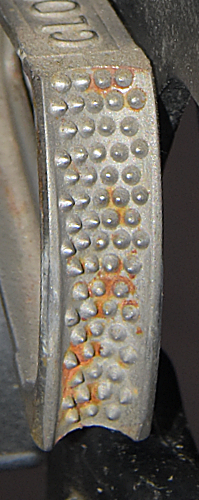 I acquired this pair used from Anthony Morton in 2007, but
it is clearly a much older design. I acquired another right-hand ascender in 2017 as part of Bob Thrun’s collection.
I acquired this pair used from Anthony Morton in 2007, but
it is clearly a much older design. I acquired another right-hand ascender in 2017 as part of Bob Thrun’s collection.
Version J is 195 mm. tall, 104 mm. wide, 25 mm. thick, and weighs 228 g. The rope channel is 16 mm. wide. The cam radius increases from 43 to 58 mm. over an angle of 41°, giving a 23° cam angle. The tooth pattern is (4.5)^4(4.3)^4.
"CLOG-WALES" is molded into both sides of
the plastic hand grips, and "CLOG" is cast on top of the cam.
Version J differs from Version I by having a plastic
thumb safety catch instead of an aluminum catch. Since the catch
is unlikely to break, this change also has little impact on the
ascender’s functionality.
[ Top
| Version A
| Version B
| Version C
| Version D
| Version E
| Version F
| Version G
| Version H
| Version I
| Version J
| Return to H.E.C. Ascenders
]
Version K
(#26, 172, 2167)
Technical Details
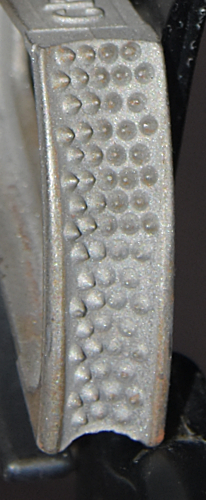 I acquired this pair from Exkursion in 1993. I acquired a third (right-hand)
ascender used from Terry Wilkins in 2004. I acquired another left-hand ascender in 2017 as part of Bob Thrun’s collection.
I acquired this pair from Exkursion in 1993. I acquired a third (right-hand)
ascender used from Terry Wilkins in 2004. I acquired another left-hand ascender in 2017 as part of Bob Thrun’s collection.
Version K is 194 mm. tall, 105 mm. wide, 26 mm. thick, and weighs 236 g. The rope channel is 17 mm. wide. The cam radius increases from 43 to 58 mm. over an angle of 41°, giving a 22° cam angle. The tooth pattern is (4.5)^4(4.3)^4.
"CLOG-WALES" is molded into both sides of
the plastic hand grips, and "CLOG" is cast on top of the cam.
Version K adds a pin cam stop to the Version J design.
This keeps the cam from sticking when the ascender is off rope, but
has no function when the ascender is in use.
[ Top
| Version A
| Version B
| Version C
| Version D
| Version E
| Version F
| Version G
| Version H
| Version I
| Version J
| Version K
]


